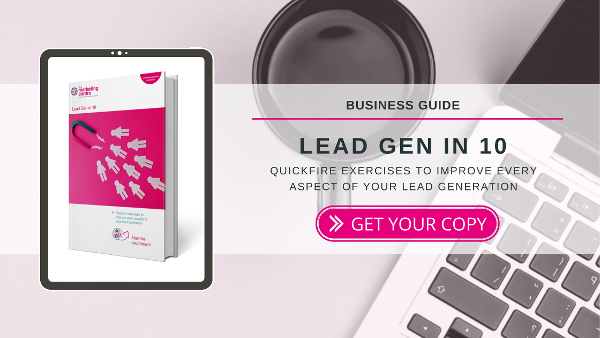Marketing generates leads. Sales close them.
That’s how it works, right?
In reality, the best chance of success comes from sales and marketing working together to identify where the greatest opportunities are and what’s needed to get those deals over the line. Marketing is instrumental to the planning process - but should also keep adding value for potential customers right up until the point of them signing the contract and beyond.
Here are eight ways your marketing and sales teams can work together to close more deals.
1. Finding the biggest opportunities
Marketing can help your sales team be more strategic and data-led about where the greatest opportunities are. Analysing the data in your CRM (or whatever sales analytics you use) can answer important questions like:
- Which customer segments are buying the most?
- What products or services are they most interested in?
- What problems are they trying to solve (or goals are they trying to achieve)?
This will unlock valuable insights that will help you be more strategic about:
- Who to target
- What products or services to offer them
- The value propositions (or bundles of products and services) that will have the highest chance of success
Armed with these strategic insights, marketing can then develop messaging or content that will help generate leads and close deals. Here are some of the marketing assets that we’ve found help accelerate the sales process.
2. Create compelling case studies
Your prospects need to know that your product or service actually works. Case studies - used both before and during the sales process - can demonstrate how working with you has provided tangible benefits to other customers.
A good case study isn’t about you. It’s about the problems that were solved or advantages that were gained because a customer chose your product or service. It should tell the story of the problem or pain point the customer needed to solve, the solution you provided and the results.
After the sales team recommends suitable customers for case studies, marketing interview the customer and create a story that is compelling and builds trust.
3. Produce a winning sales deck
Sales decks are used to pitch to prospective clients why they should work with you. It’s essentially a way for Sales to communicate your value proposition.In pitch decks, skilful storytelling is vital - which is where marketing comes in. Creating your sales deck as a combined effort can ensure that the document works as hard as it possibly can in pitch meetings.
Your sales deck should summarise:
- Who you help
- What your customers struggle with
- How you help them
- Why you’re better than competitors
- Proof of your track record
It should be visually appealing, clear and succinct, as well as easy to customise for different prospects.
5 quickfire exercises to improve every aspect of your lead generation
Everything you need to know to generate more leads.
Get our Lead Gen in 10 workbook today.
4. Harness the power of video
Marketing can help your sales team work out what to say, but they can also help find the most impactful medium. Video is one of the most impactful formats out there. It’s also much cheaper and easier to create than it used to be.
One-to-one video solutions, such as Vidyard or Loom, are often free to use and can be highly impactful. And video is versatile, too: it can be used for everything from testimonials to product demos to creating short, snappy content for social media.
As with case studies, successful video content is all about storytelling: pitching to the right audience, using the right language, and providing compelling content. Get sales and marketing together to plan and create videos that truly convert.
5. Produce sales enablement content and FAQs
The average B2B buyer will consume 13 pieces of content before making a decision.
Your sales team will need access to the right content at the right time to encourage prospects through the sales pipeline. Whether it’s blog posts, white papers, FAQs, or other forms of content that help your sales team demonstrate value, sales enablement content is well worth the effort.
Get in touch for expert marketing support to help you achieve your sales goals.
With Marketing creating content that explains how your product or service works and gives your prospects the information they need, you’ll be better placed to tackle any questions or objections, and will know that the leads your sales team is speaking to are as educated as possible.
6. Create experiences as well as content
By combining forces, your sales and marketing teams can create far more than collateral. Open days, reference visits and management engagement can all help build the relationship and bring your products or services to life. These activities should be mapped against the pipeline stage, so sales know when to use each.
Is your marketing activity up to scratch?
7. Support with personalised content
Customising content for your target audience can increase engagement, raise conversion rates, improve your campaigns, and demonstrate to your prospects that you really understand their issues and challenges. It need not be complex either.
Content can be personalised in many different ways, based on:
- Industry or segment
- Stage of the purchase journey
- Buyer persona
- Individual organisation
- Individual lead
The personalisation options at the top of the list are more generic, working their way through to more specific and targeted custom content at the bottom. Sharing sales team information with marketing can help marketing create personalised content that truly meets the sales team’s needs, demonstrating a high level of thought and care. Make sure that sales know what is available to them depending on who the prospect is and their stage in the buyer journey.
8. Communicate regularly
One of the best ways to get marketing and sales to work more closely is to facilitate regular discussions between the two teams. These discussions can help to establish:
- What sales have done with the leads created
- What the quality of leads has been like
- What both teams can do to help move leads forward
- Whether anything new can be done to benefit current prospects
- Any friction points in the sales pipeline that they can help to resolve
Marketing and sales often - and wrongly - operate in two separate silos. Remember too that marketing’s role does not end with the sale. Working together on areas like customer comms and NPS can help to ensure that a new customer becomes a delighted and loyal customer.
A shared goal
Marketing and sales are working towards the same goal: to help the business grow by securing new customers or growing existing accounts. Marketing can help sales identify where the greatest opportunities are and how to unlock them.
The best chance of success comes from clear and transparent communication and clear roles, responsibilities and objectives. When sales and marketing are able to work together, the customer experience is dramatically improved, which is good news for everyone involved.





